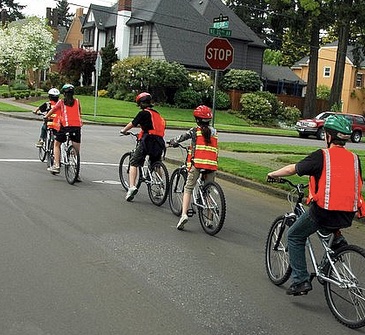The Bicycle Transportation Alliance’s campaign to get walking and biking education and infrastructure to public schools across the Portland metro area got two strong boosts this month.
In successive unanimous council resolutions, the suburban cities of Milwaukie and Tigard voted on March 17 and 24 to ask the Metro regional government to dedicate funding to programs like the ones currently enjoyed by many Portland elementary and middle schools.
“Our goal is for Tigard to be the most walkable community in the Pacific Northwest where people of all ages and abilities live healthy, interconnected lives,” Tigard Mayor John Cook said in a BTA news release. “Providing a safe route to school for every kid is essential to the health and safety of our community.”
Various Milwaukie and Tigard residents had more to say in the BTA’s release:
Research shows that kids who most need opportunities for physical activity don’t have the necessary safe infrastructure—sidewalks, crosswalks, bike lanes—in their neighborhoods and around their schools to support a healthy childhood.
In Clackamas and Washington Counties, more than 70% of 8th graders are not getting the recommended amount of physical activity according to the 2013 Oregon Healthy Teens Survey. Lack of physical activity is a leading contributing factor for obesity, diabetes and heart disease—a problem for Oregon, where one in four kids is overweight or obese.
The proposed region-wide Safe Routes to School initiative — “For Every Kid” — represents a chance to address these problems. Walking or biking to school can help kids meet over half of their daily recommended physical activity, and public transportation users have been shown to get three times as much physical activity.
“We need sidewalks and a more visible crosswalk,” said Ane Roth, Milwaukie resident, Linwood PTA representative, and mother of two boys. “My kids and many more could walk and bike if the street in front of the school was safer.”
Advertisement
Roth and other Linwood parents have been working for the last year to increase walking and biking to school by leading encouragement activities, however, the streets are not safe for every child to participate.
School surveys show that at least 60% of students at Linwood want to walk and bike to school, but parents don’t allow it because the streets need sidewalks and other safety features. Instead, about half of students are driven to school. This is greater than the percentage who ride the school bus and significantly more than walk and bike according to surveys. Parents identify the major reason why they want their children to walk and bike is to increase their child’s health.
“Childhood obesity is a reality for far too many children in our community while many neighborhood streets lack sidewalks,” said David Lord, teacher at Metzger Elementary in Tigard. “With regular exercise, students are more attentive in class. Kids need safe streets to be able to get around and to learn about how to walk and bike safely.”
This call by the cities of Milwaukie and Tigard is part of growing demand across the region for safer neighborhood streets that support healthy communities, but funding for such projects is limited.
This fall, Metro Councilors will have the opportunity to allocate funding to make safe routes to school for every student in the Metro area. Creating dedicated funding would ensure the safety and health of our kids, families, and communities.
The BTA says that education throughout the metro area would cost about $28 million a year, or $375 per student: $2.7 million for education and encouragement, the rest for transit access, street improvements and needs assessments. They’ve drafted a policy document that breaks out the various costs and possible funding sources.


